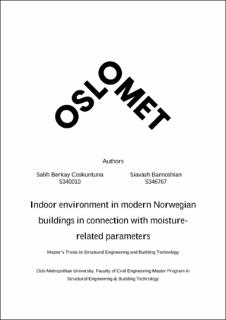Indoor environment in modern Norwegian buildings in connection with moisture-related parameters
Master thesis
Published version
Permanent lenke
https://hdl.handle.net/11250/2774020Utgivelsesdato
2021Metadata
Vis full innførselSamlinger
Sammendrag
The data collected for this thesis was real data measured in residential apartments.
The focus and objective of this project was called healthy, energy-efficient urban home ventilation (NFR 2020-2024); where this thesis was a part of that research made in collaboration with SINTEF Community.
Relative humidity can be as low as 10% in Norway due to the cold winters, which can have a negative effect on people and equipment indoors. This paper has its aim in answering how the indoor environment is in connection with moisture and temperature associated with each room and the peaks of its humidity in modern Norwegian residential buildings, it also has a focus on how the residents of the apartments perceive the indoor environment.
This research aimed to answer these questions based on firstly field experiments where sensors were placed in the apartments for a duration of a week to measure relative humidity, temperature and CO2 as well as pressure in main rooms of the apartments, secondly an online survey which was aimed at the apartment residents of the field experiments and thirdly computer simulations of the indoor air environment.
The findings showed that, in general, relative humidity levels observed in the monitored apartments was relatively low, e.g., the mean values lower than 26% for every room without a humidifier. While the mean moisture excess was found as lower than 1.36 g/m3 for every room without a humidifier which was lower than what is found in the literature by other researchers. Additionally, the findings showed a moderate positive correlation between cooking events and moisture excess levels. Furthermore, the WUFI®PLUS simulations further strengthened the field experiment results and gave insight into the whole year results.
